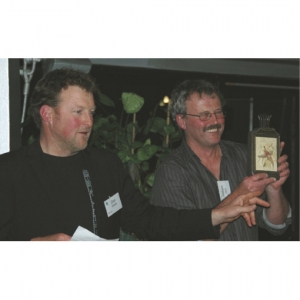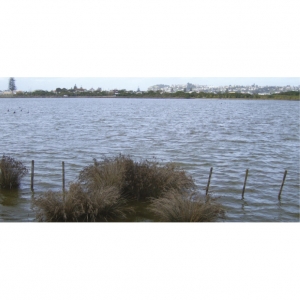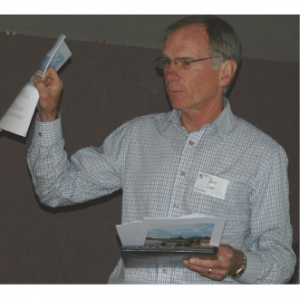Displaying items by tag: AGM 2013
AGM 2013 Minutes
Welcome:
The President, David Smith, welcomed members to the 38th Annual General Meeting.
Many thanks to Di Pritt and Waimarino Wine Club for a very enjoyable evening last night.
David spoke of the end of his presidency – but still a lot of work to be done. DU faces a crisis in interest and membership.
He spoke of the Boards time spent looking at alternatives in the drive for younger members. Advice was sought and some possibilities have come out of that. We could look at the possibility of getting together with all like organisations, e.g. Forest & Bird, Fish & Game, National
Wetlands Trust, and Waterfowlers to form umbrella group to go to Government. This means that we would retain identity with no merger. There is a large amount of cross fertilisation over these organisations. However DUNZ could become a member with a stronger thrust on a national basis. As a result of the discussions at Board level David and John Bishop met with Tony Roxburgh some three weeks previous. They see some merit in the idea. DUNZ is seen as having the wetland expertise. Tony Roxburgh, from National Wetlands Trust, was introduced to the AGM and gave his background. He reinforced David’s comments and said that the idea of an umbrella group had a lot of merit. It had been raised with the Trust and they were comfortable at this stage of discussion. The forming of an alliance would give all individual small groups a voice. David then asked members to talk to Board members throughout the day and give some feedback. David now needs to step back and Ross Cottle has agreed to take over his role as President.
Apologies:
Lady Isaac, Kevin and Vietta Campbell, Alan Wilks, Ossie and Mary Latham, Euan Bidwell, Chris Bindon, Barbara Hanbidge, Gordon Pilone, Rob and Robin Borthwick, Lorraine Jensen, Wendy Simmons, Shonagh Lindsay, Myra Smith, Janet Denny, John and Diny Dermer, Graham Gurr, Dawn Pirani, Andrew Fulford, Sharon Cottle, Ken and Jacqui Barnes, Pam & Brian Maunsell, Adrienne Bushell, Peter and Anne Russell, Raeleen Mabin.
Motion: That the apologies tendered are accepted.
Moved: John Bishop, Seconded: James Martin. Carried.
Minutes of the last AGM:
Circulated in Flight #150 and copies
available at the AGM.
Motion: That the minutes of the last AGM be accepted as a true and complete record. Moved: Ian Jensen, Seconded: James Martin. Carried.
Matters arising from the 2011 minutes: There were no matters arising.
Thanks to David Smith to be recorded and congratulations on appointment as Judge of District Court.
Presidents Report: David Smith As circulated in Flight #150 and tabled.
Motion: The Presidents report is accepted. Moved: John Bishop, Seconded: W Abel. Carried.
Matters arising from the Presidents 2012 Report: There were no matters arising.
Financial Report: John Bishop
Presented at the meeting – as at March 31, 2011.
Current Account $19,854
Rapid Saver $9
Term Deposit $46648
Accounts be accepted subject to the review of engagement.
Due to the timing of the AGM this year the 2012 accounts are not yet finalised. Motion: That the 2011 financial report be accepted.
Moved: John Bishop, Seconded: David Smith.
Carried.
Waterfowl and Wetlands Trust Report: David Smith (tabled). Reiterated that the nature of this investment means that it is a long term one that fluctuates, however we are almost back to the position of 2007 and the next 9 months should see an improvement. Moved: David Smith, Seconded: Jim Law. Carried.
Election of Officers:
Board Election:
The President read out the following Statement:
The Constitution states that the Board should consist of not less than six, of which half, but not more than two thirds shall be permanently appointed Directors.
As of right, the permanent appointments are the Chairman, President, Vice President, Secretary and Treasurer. Other permanent appointments are Neil Candy and William Abel.
Nominations for the Board:
New nomination from Jim Law for Andrew Fulford. Has been a long term member of DUNZ and works in wetland restoration. Moved: Jim Law, Seconded: Ross Cottle. Carried.
Are there any other nominations from the floor? None.
Reports:
Wetland Care: William Abel (tabled). Moved: William Abel, Seconded: Ian Jensen.
Carried.
Website Report: (tabled).
Michelle Cooper (webmaster) covered off her report. The website is getting a lot of hits – what is being looked at? Through the background information I am able to see the mostly looked at are news, duck facts and wetland facts and 69 percent of people are coming to DUNZ website directly.
Quack Club now has 80 members. Five schools are using our resources.
Moved: Jim Law, Seconded: William Abel. Carried.
Wairio Wetland:
Jim Law (Full report tabled).
Covered off report. • Have raised profile and credibility • Maintaining good coverage in media • Looking to ratchet up project due to success • Need to update strategic plans • Making a case to DU Board for further funding. Moved: Jim Law, Seconded: John Bishop. Carried. Jim Campbell proposed a vote of thanks to Jim Law for his energy and hard work with Wairio and said that without Jim it all wouldn’t happen. Pateke: Full report tabled
Opuatia Report:
John Bishop - This project is in abeyance.
General Business:
Received an email regarding DUCs 75th anniversary at Oak Hammock Marsh
DUNZ AGM – to go back to winter time scenario. July/August. Aware that we need to keep costs down.
Dart competition at Di Pritts last night raised $46 with the winner getting 102 points in 2 shots!
Ian Jensen spoke of Pharazyn Reserve - a KCDC project for the rehabilitation of an old wetland in Waikanae. Local schools are heavily involved but very light on members.
Thanks to Liz Brook for Flight magazine.
Closure:
The President thanked the Board for their work throughout the year.
The meeting closed at 10.20am.
Pekapeka wetland earns Pride of Place award
One of the areas to be visited during the AGM weekend.
Hawke’s Bay Regional Council was delighted to receive a Distinction Award from the New Zealand Institute of Landscape Architects at the NZILA Resene Pride of Place Landscape Architecture Awards for 2013 in April.
The citation for the award states that Pekapeka Wetland provides a range of experience opportunities for users and acknowledges the contributing work of Shannon Bray Landscape Architect.
Stephen Cave, HBRC’s Operation Environmental Manager said “This is one of three awards for Pekapeka Wetland since 2009, realising its champion value and raising the awareness of wetlands throughout Hawke’s Bay.
“The award from NZILA is a great reflection on the restoration work happening in Hawke’s Bay and we are very honoured. It is estimated this award puts Pekapeka Wetland in the top five percent of landscape architecture projects undertaken throughout New Zealand in recent years.”
The award recognises Pekapeka Wetland as a high quality interpretive site for wetland restoration. It is noted for integrating public accessibility with educational features, using local materials and stories.
Stephen is quick to acknowledge a number of the project’s key supporters, particularly Shannon Bray, Waa Harris, Peter Dunkerley, the Community Foundation, Rotary Club of Stortford Lodge, Eastern and Central Community Trust and the preliminary work of Titchener Monzingo Aitken Ltd.
Iwi groups plus many children from schools (particularly Pukehou School) and Kiwi Conservation Club all played a key role in planting areas around the swamp.
Auction - fun and drama
New auctioneer gets the dollars
Two successful auctions, one silent, the other noisy and very lively, kept members alert with lots of laughter to boot.
Auctioneer Dan Steele successfully filled the big shoes left by Bob Wood who sadly died in February this year. Dan’s banter was every bit as funny as Bob’s had been, and he cajoled many a bidder to go “just that little bit higher”.
The main auction raised $5255, the silent auction plus the raffle raised $1540. All thanks to those members who donated some amazing items for the auctions and the raffle.
Pekapeka Swamp – an icon for Hawke’s Bay
Our intrepid group of AGM attendees visited the Pekapeka Swamp, squeezed in between the railway on the Eastern side, and State Highway 2 on the West. This area is well known to travellers who use SH2 south of Hastings. Older people who passed this way remember the swamp as being totally overgrown by grey willow. Steve Cave, Operations Environmental Manager for the Hawke’s Bay Regional Council (HBRC) explained the 98ha site is being restored to protect the cultural and historical value but also to help people understand the significance and important part wetlands play.
When Maori arrived in the area about 1530 this peat swamp, part of the limestone area, would have been very different. Its trip down hill started in 1873 with the dumping of rubble, fill and waste. The rail line was built in 1875. Between 1942 and 1970 channels were dug to drain the swamp, and in 1955 SH2 was straightened, cutting through the western side.
In 1970 Pekapeka was made a reserve. Willow control started in 1984 and finally a management plan to restore the wetland was approved by the HBRC. Helicopter and ground spraying targeted the willows. Community and school groups have put in many volunteer hours at the swamp. A clearing programme improved the flow of water through the wetland, and controlled animal and plant pests.
A plain to restore the wetland was approved by the HBRC in 1998. Work included a weir with a fish passage, to manage wetland flow, and funding allowed the site to be developed as a public reserve. Illegal dumping had continued at Pekapeka for many years and as a reminder of how wetlands had been treated it was decided to leave some rubble and reinforcing rods exposed as a reminder of the past.
Pekapeka opened to the public in 2010. Board walks, observation decks and even hides provide access and viewing points. Information boards give background and there is a picnic area. No toilets though. During duck shooting members of a local club use half the area and it is closed to the public. Club members are also involved in a predator control programme.
Steve said red tape, and resource consents often hold up restoration. So far it has cost them $60,000 for consents, eating into the small amount of funding they do receive. Thank goodness for volunteers.
Help at hand for Waikato wetlands
Tony Roxburgh, chair and trustee of the National Wetland Trust provided the AGM with a glimpse of happenings with wetlands in Waikato.
The Trust plans a state-of-the-art interpretation centre, with research and educational facilities, wetland gardens and heritage trails on land next to Lake Serpentine in the Waipa district. This is one of 69 peat lakes in Waikato.
Issues to be worked through include highway access and formal agreement with the Department of Conservation. DoC has already given approval to construct a 1.4 km predator fence around 10ha of the reserve at Lake Serpentine near Ohaupo.
Tony said the plan includes a visitor concept plan, an interpretation plan, business plan and landscape developed for the site. These were funded by grants from Transpower, Trust Waikato and Waikato Regional Council (Environmental Initiatives Fund), and supported by Waipa District Council.
They are looking at the best way to restore wildlife, including the feasibility of a predator exclusion fence. Funding from the Waikato Catchment Ecological Enhancement Trust, and a grant from the DoC’s Community Conservation Fund allowed them to produce a re-vegetation plan to restore vegetation and habitat.
Students of Te Awamutu School have been searching for native and exotic fauna, and have been the first to confirm long-tailed bats at the site. Other species confirmed include Australasian bittern, North Island fernbird, Black mudfish and Spotless crake.
The pest fence was completed in June this year and they now need sponsors and donations to help with pest eradication and re-introduction of native species.
Other work in the Waipa district includes Lake Ngaroto one of the peat lakes. It currently floods the peat and Tony said this could be one of the larger projects for the Waikato basin aimed at reducing loss of wetland and preserving the quality of the peat lakes.
Web Feet and Websites = Ducks Unlimited
It is satisfying to see the steady rise of Ducks Unlimited website usage over the last year. Contributing factors are the great work DU are doing in Wairio and country wide, the improvements we are making to the site, word of mouth and a substantial amount of traffic directed to us by Google searches, mostly people looking for information on our webfooted friends.
Also on a rise - the use of our facebook page with now 161 members . It is a great venue to share thoughts, facts and photos on conservation and wetlands. A great place to visit and scroll through the ‘posts’ to get news on DU and other conservation organisations. We are linked with many organisations through Facebook, sharing and exchanging relevant information, as is the social networking way.
I have proudly been involved with DU’s website and other promotional projects for about three years. In that time the site has had a bit of a facelift, new additions and plenty of changes. Work continues and we look forward to further use of these resources in the coming year.
If you have not visited our website or facebook site we urge you to:
DUCKS UNLIMITED www.ducks.org.nz
QUACKCLUB (kids club) www. quackclub.co.nz and
FACEBOOK www.facebook.com/pages/Ducks-Unlimited-NZ/142374525787862
Michelle Cooper
The birds’ place – the Ahuriri estuary
An interesting visited during the AGM Conference
was the long, narrow Ahuriri estuary. We travelled by bus, so there was no chance to dip a toe in the water. With its wide range of fresh to salty, shallow to deep, and sandy to muddy habitats the estuary supports a diverse range of birds, fish, invertebrates and plant life.
It is a sanctuary for a wide variety of wading birds including Grey herons, Royal spoonbills, Pied stilts, Shags, Kingfishers and Gannets. Over 70 species of resident and migratory
waterbirds use the estuary as a feeding and resting area. Bar-tailed godwits/kuaka, Knots and Golden plovers migrate here each year from their arctic breeding grounds.
Fun, games and serious stuff at AGM
Jim Law explained what is happening at Wairio Wetland in the southern Wairarapa when he presented the following at this year’s AGM.
During 2012/2013 restoration work increased significantly and the research programmes by Victoria University’s Wellington School of Biodiversity and Restoration Ecology were expanded to include nutrient studies and hydrology.
However, of greatest interest are plans we have been pursuing for some time to reticulate water from the neighbouring Mathews lagoon (and possibly boggy Pond), under the Parera Road and into the Wairio Wetland. This would be a great boost to the health of the Wetland and assist in stripping nutrients before the water finally reaches Lake Wairarapa.
This year’s increased work cost just over $25,000 (prior year $15,000), and was once again financially supported by the Nikau Foundation, Rotary, the Pharazon Trust and the Ron Greenwood Trust and the Estates of two former DU members, Bruce McKenzie and Ron Brookes. Greater Wellington Regional council also contributed funds received under the Government’s “Fresh Start for Fresh Water” programme. In total third parties contributed $15,000, with the balance of $10,000 coming from DU resources
For the 2013/2014 year we have an even higher budge of $35,000. Key items include our normal planting, led by DU’s Trevor Thompson and again involved a number of our stakeholders, notably pupils from the local Martinborough School, students from the Taratahi Agricultural Training Centre, Rotarians and other interested parties, including of course, DU members. Good local media coverage was provided by Gill Lundie, the Wairarapa Chapter Chair. Further planting is planned for late August brings the total for the year to 4000 plants – a record!
The other main 2013/2014 item that has been completed is the construction of a bund wall around the western side of Stage 4 that has retained significant water in the Wetland. Wairio is no definitely being seen as a success story by the wider community and DU’s profile has grown accordingly.





